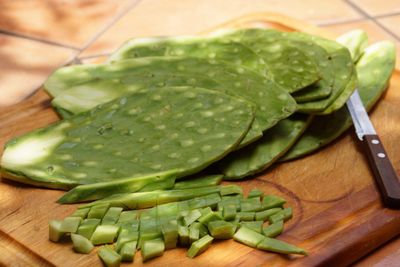Can You Eat Cactus Pads?
If you have ever been to an ethnic store specializing in Mexican and southwestern cuisine, you may have seen cactus pads. The plants grow especially well in desert type areas and adult plants can produce 20 to 40 pads per year. The locality where the plants grow wild call the pads nopales, a desert delicacy that has been transported across the states. There is a specific time of the day and year for harvesting edible cactus pads. Harvesting nopales at the optimum time ensures less acid content and a sweeter vegetable. Prickly pear cactus is the primary source of nopales. In spite of the pad’s armament, they have been used for food probably as long as humans have been in their native region. Nopales are eaten either raw or cooked. Once cooked, they have a slightly slimy texture much like okra, but the flavor is appealing and adds a lemony note to recipes. You can often see nopales canned in specialty stores or the Mexican section of the supermarket. You use these like you would any canned vegetable. The cacti are raised commercially in Mexico, but you can also harvest your own pads if you live in an area where Opuntia are common. Harvesting edible cactus pads is a bit like raiding a honeybee nest. The opportunity to get stung does exist.
When to Harvest Edible Cactus
You can harvest the pads at any time of the year. However, knowing when to harvest edible cactus for best flavor will ensure sweeter vegetables. The best time is midmorning when the acid content is still low. Since the pad already has a tart flavor, you want to avoid any bitterness that might occur if you harvest later in the day. Mature cactus can be harvested up to six times per year. Just remember, as with any plant, ensure that at least 2/3 of the pads remain on the plant to fuel photosynthesis and energy gathering.
How to Pick Cactus Pads
The first step when harvesting nopales is to arm yourself. Dress in long sleeves and thick gloves. Tongs are helpful, as is a sharp knife. Grasp the pad with the tongs and cut it where the section joins to another pad. Remove the pad using the tongs and place it into a bag. A burlap or fabric bag works best, as a plastic bag is no match for the spines. Once you get the pad home, wash it using the tongs again, use the knife to scrape off the spines. You can then peel off the skin if you wish and use the vegetable raw in salads or sautéed, boiled, and roasted. You may also choose to use the pads medicinally, much like an aloe plant. The sap in the pad apparently also repels mosquitoes. This amazing cactus has numerous uses, is easy to grow, and is a symbol of the American Southwest.
